Imagine an enormous, lush island, quietly existing at the heart of a gigantic river. So enormous, that once you’re a little away from the banks, you will find it hard to believe that you’re anywhere near water. The only way to reach here is via a large, overcrowded ferry, that ships people and vehicles, all at once.
Torrential rains and cyclopean floods dismantle settlements every year, eroding large chunks of the isle and leaving behind clayey wetlands called ‘beels’. Yet, the natives never reduce their residence here to a transient one.

Image Source: Mising Tribe (mishing_tribe_of_assam)
The foggy island is in fact inhabited by a fairly rich ecosystem – endowed with evergreen grasses and deciduous trees, aquatic plants, marsh vegetation, bamboos and canes; and graced by glorious migratory birds like pelicans, Siberian cranes, warblers and cuckoos.
To tackle rising water levels, sustainable stilted bamboo houses are laboriously self-constructed. Most houses might not have concrete floors, but are equipped with small handlooms to weave cloth, and a full-fledged wood-fired slow kitchen which doubles up as a beer brewery in the evenings. Fresh produce cultivates on backyard farms and livestock graze on fresh grass. Kids, with their fishing poles, patiently lean into backwaters that accumulate in fields, and triumphantly bring in fresh catch for supper. Here, you’re inside an ecosystem that is circular, remarkably self-sufficient and carefully preserved.
This is Majuli – an enchanting land, where nature, sustainability, art and ecological innovations synchronously thrive.
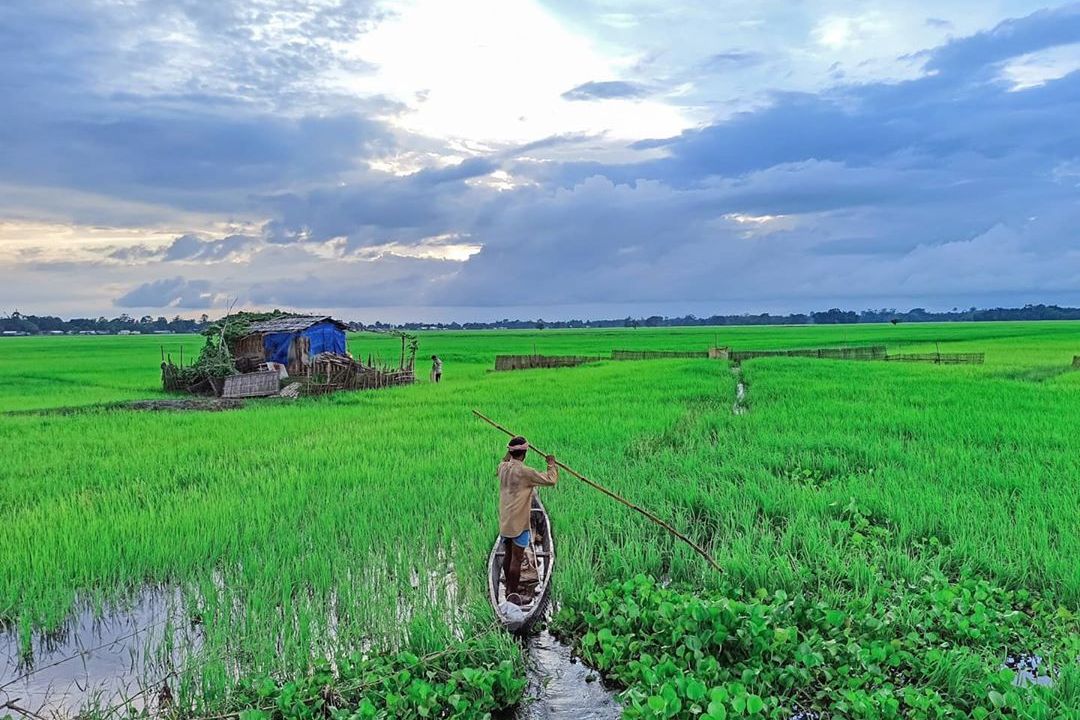
We started walking towards Monjit Risang’s diner-house at 6:00 p.m. The streets of Majuli were deserted by then. The sound of our shoes treading on slippery turf, the sopranos of lurking crickets, the smell of monsoon and indistinct silhouettes of huts and trees were the only elements interrupting the dense canvas. Dinner preps would have been halfway through in most households and the river island seemed to have retired for the day.
Along the way, we made a short visit to another friendly Mishing neighbour for a quick swig. The islanders are seasoned brewers, who craft some very well-rounded, antidotal rice beer, called apong. We entered their dimly lit kitchen, where the earthenware was set atop the firewood and a fresh batch was being fermented.
Almost every Mishing household produces their own beer from scratch, rendering the island its diverse range of exquisite brews. Here, we learnt that the essence of fine-quality Mishing beer lies in perfectly crafted epob.
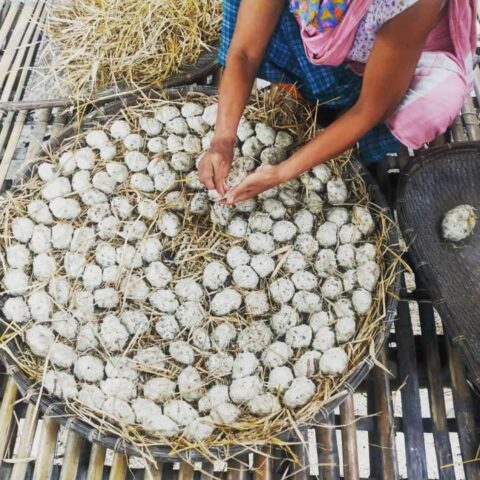
Image Source: Tales of pakkomgurban (tales_of_pakkomgurban)
These are egg-shaped starter cakes prepared with rice powder and a carefully handpicked assortment of over twenty flavourful forest leaves, barks and herbs, including jackfruit leaf (kothal paat), wild pepper (bon jaluk), wild fern (biloghoni), sugarcane leaf (khuhiyar paat) and betel palm root (tambol).
These yeast starters, are then used to brew two varieties of the traditional Mishing beer, the dark tipple – poro and nogin, the light one. We sampled the nogin, which was a milky-white craft beer, with a bitter-sweet profile and fruity-herby notes.
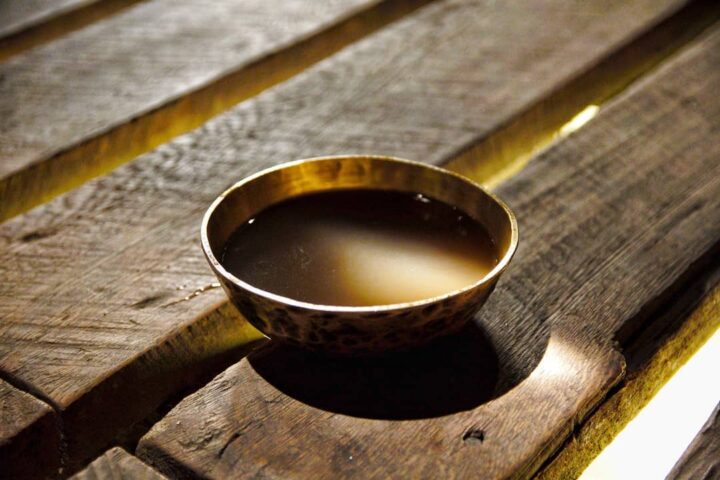
Image Source: Nitin Pegu (neatpegs)
Hungry and mellowed, we reached ‘Risang’s Kitchen’ at supper time. The modest open-kitchen diner, was a traditional stilted cottage, locally known as chang ghar. Its walls, pitched roof, and floor were made of bamboo culm and it was raised over two feet above the ground with concrete and bamboo pillars.
Risang’s is an experiential extension to ‘Le Maison De Ananda’ (the House of Happiness) a Mishing cottage stay designed by French architect Jim Chauvin, on his visit to Majuli in 2005. Since then, Monjit runs the property and has built more cottages to accommodate rising demand.
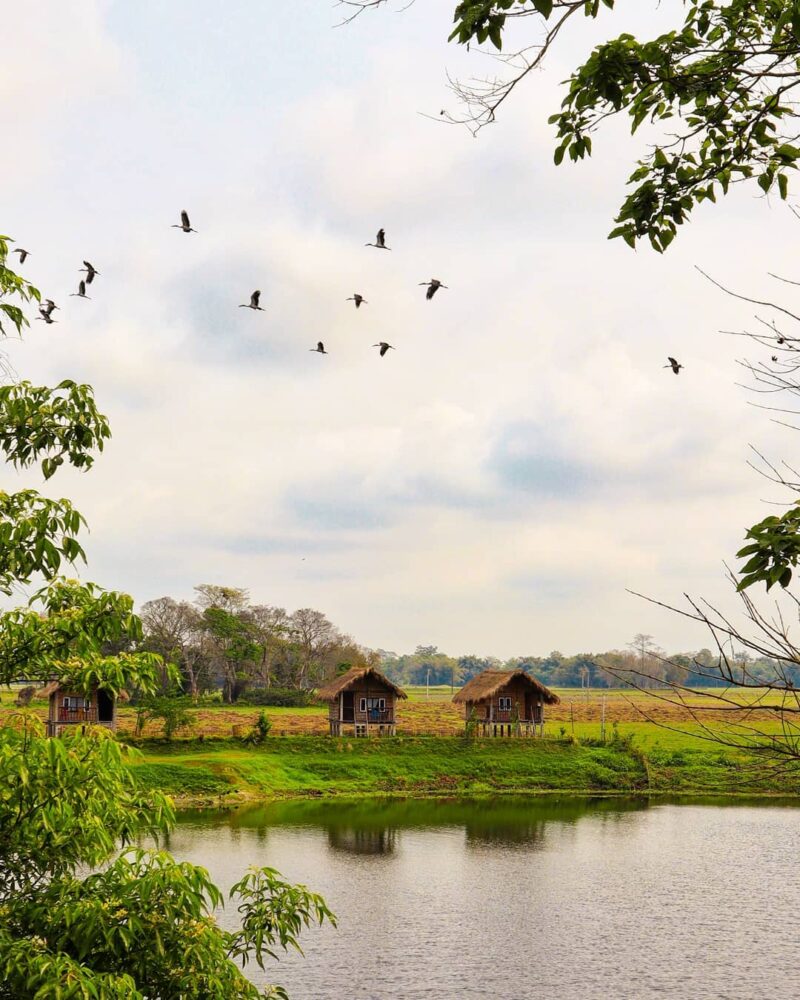
Image Source: Roshan Singh (exploroshan)
In charge of the kitchen was Nayanmani Risang, ‘my queen’ as Monjit fondly introduced her. She didn’t talk much, wore a heart-warming smile and was busy preparing dinner for the many guests who were slowly walking in.
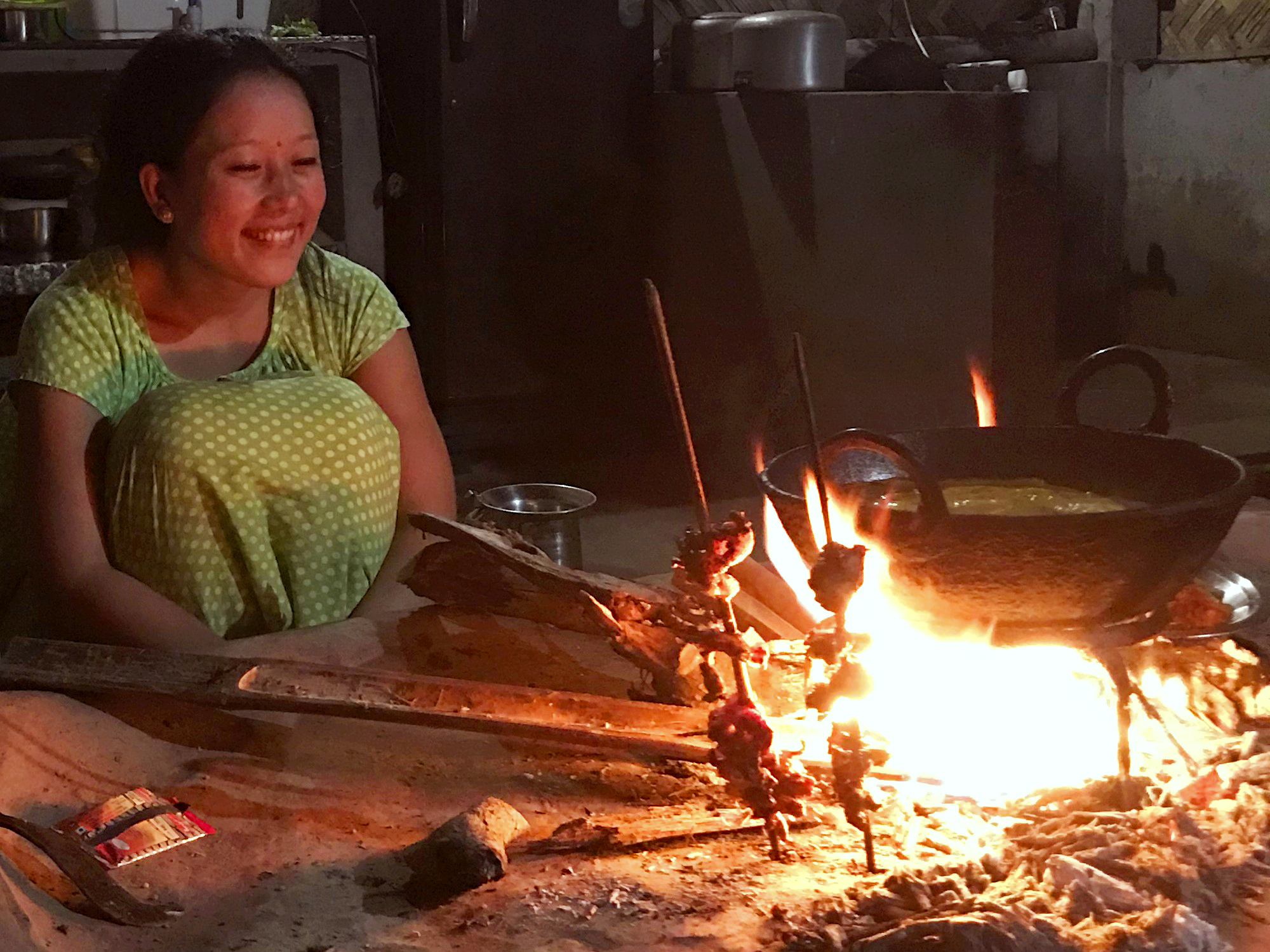
The Mishing cooking setup, locally known as meram (pronounced merom) is essentially a thick clay base, about a foot high, with woodfire placed atop its centre.
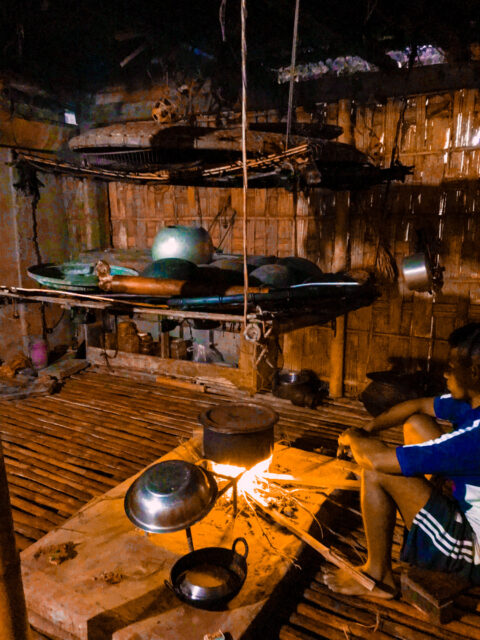
A large kadhai (Indian wok) was placed on the fire, and inside the kadhai, simmering away was good old mosur dal (red lentils), its familiar aroma lending a temporary sense of home. Encircling the fire, pierced into the clay base were skewers stacked with pieces of locally bred chicken (kukura), borrowing heat from the fire and glistening in their own grease.
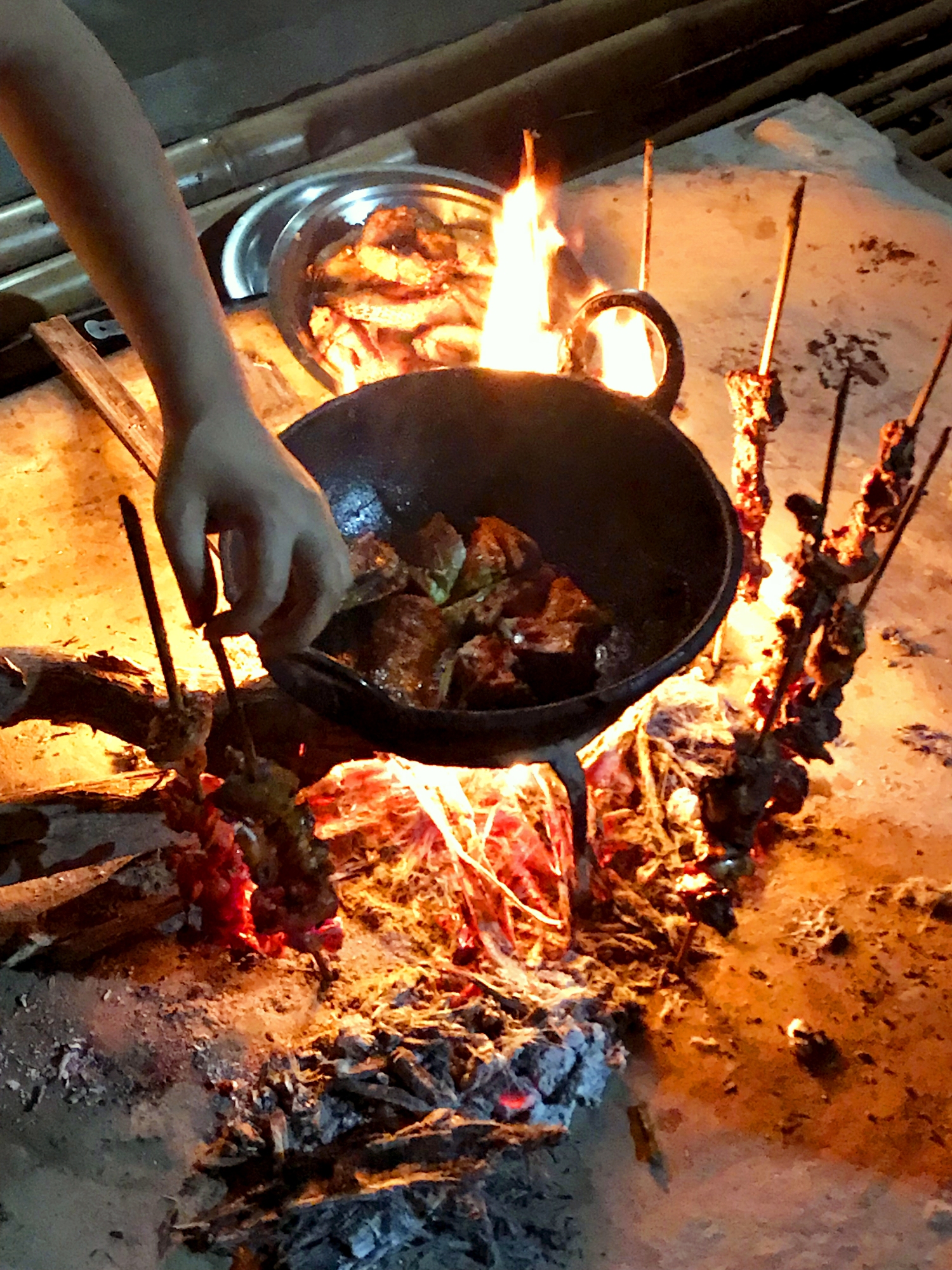
Visitors bridging generations, professions, and continents, sat on the small bamboo ottomans placed around the meram to keep warm and savour the immersive experience of a Mishing kitchen.
Monjit, with his relatable humour kept us breaking into laughter while Nayanmani would keep a check on the food as it cooked, looking away only occasionally to laugh along.
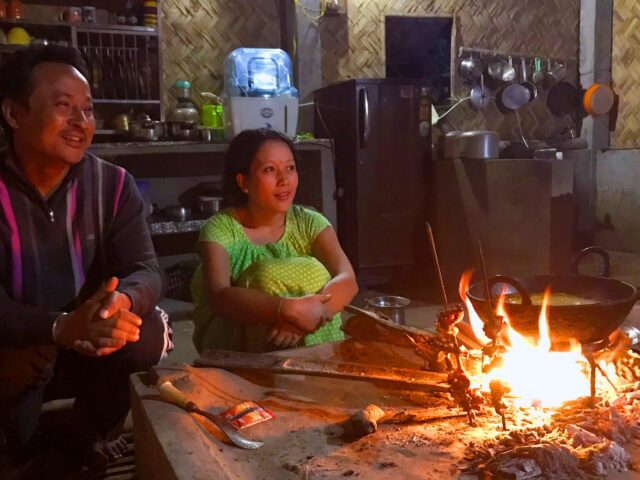
Sitting across us, on the other side of the meram, Monjit took us through the details of some native Mishing delicacies. Usually, for tourists who make prior reservations, the Risangs prepare some traditional dishes, from a diverse selection including,
purang apin – rice wrapped and cooked in tora paat (Alpinia Nigra leaf) which permeates its flavour into the rice,
patot-diya maas – fish like bronze featherback or carplet, marinated in mustard, salt, onion and ginger-garlic paste, wrapped in banana leaves and cooked under searing wood,
namsing – chutney of dry fish,
kukura khorika – skewered roast chicken.
The specialties also include fish, chicken and pork cooked in bamboo pipes, locally called naming.
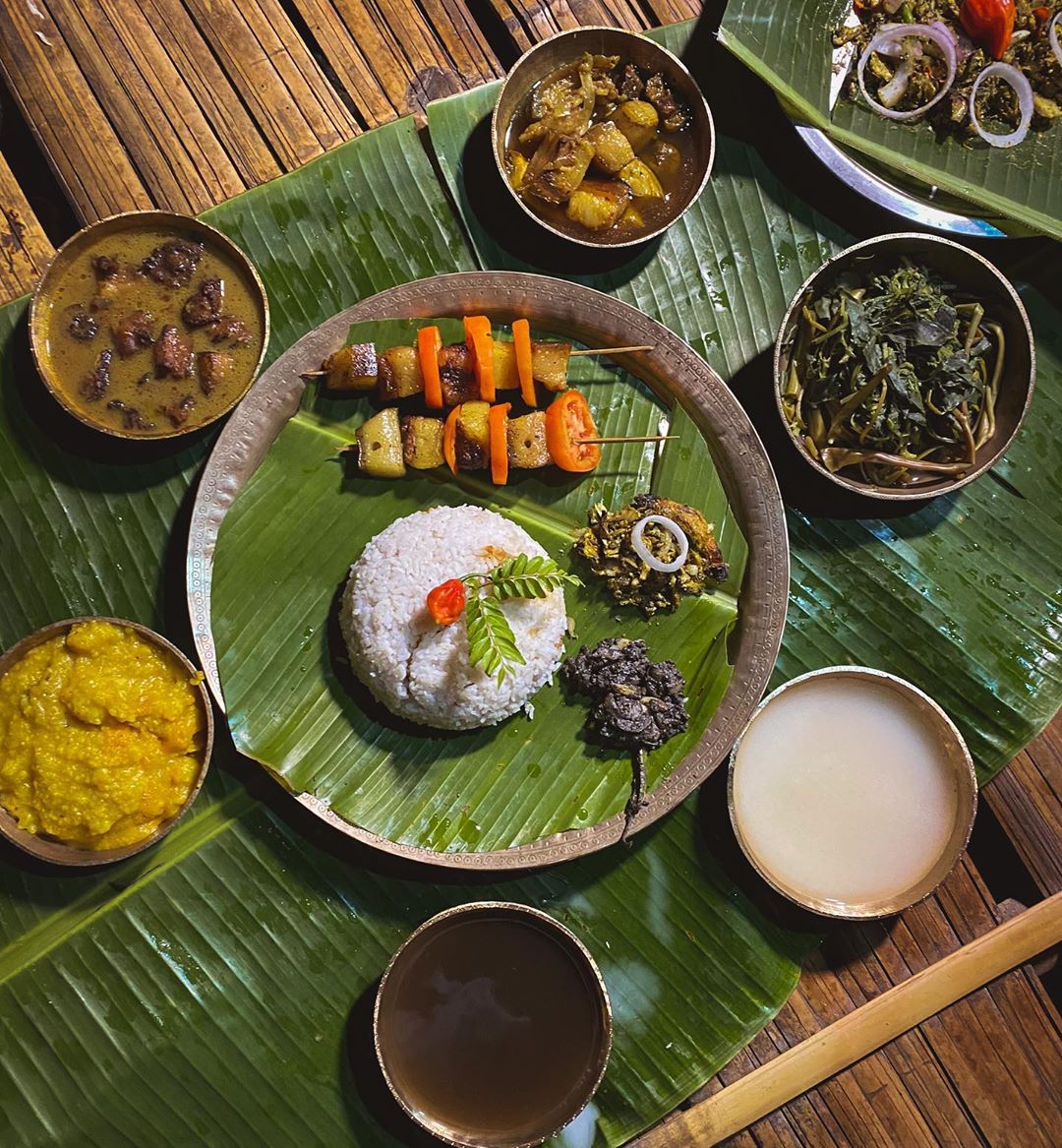
Image Source: Awesome Assam (awesomeassam)
Our dinner was spontaneous, so it comprised of the very basics of an everyday meal, stripped off of all the touristy packaging. It was what a family would eat on a weekday. Informal, rudimentary, sublime.
One by one, on a single fire, vessels of dal, rice and vegetables were prepared. A few feet above the fire, suspended from the ceiling was a bamboo rack known as dhua chang (smoke platform/house). Cleverly placed, the wide frame was set up where just the right amount of smoke from the fire would reach. Once the chicken slowly cooked into a lustrous aromatic feast, Nayanmani would carefully check them and place them on the dhua chang to render a smoky flavour and bring them to perfection.
The process of cooking on the meram is time consuming. In Majuli, this time is well-utilised. Here, this space of intimate communication – where culinary anecdotes are shared and batons of tradition are passed on – is open to whoever cares to join in. By removing the visual and interactive barriers between the kitchen and the table, the process and the plating, the chef and the diner, traditional kitchens like Risang’s serve an unparalleled, honest experience – something city dwellers are ignorantly devoid of.
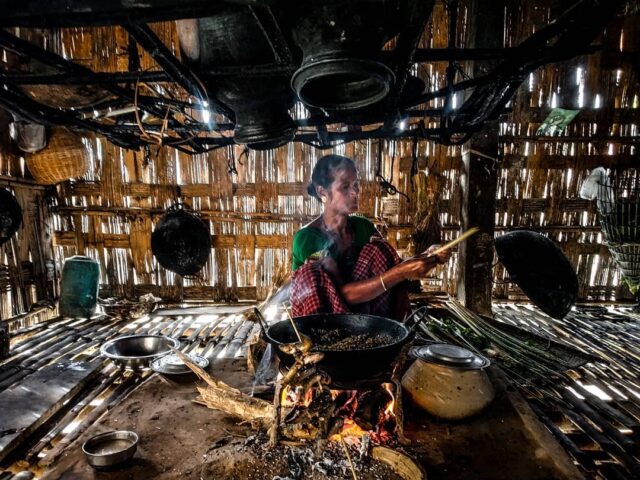
Image Source: Arpit Saikia (arpitsaikia)
The room was filled with unfamiliar conversations between people who shared a need for cultural respite. An Israeli couple spoke of their tough years of mandatory military training. A young Japanese man spoke of his happiness on finding abundant pork in Nagaland. A couple, one of whom was an architect was planning another cottage for Le Maison De Ananda.
The alleged privileges of city life nettle you the most when you find yourself in such settings. The fast life estranges us from the simple joys of sharing a conversation with another as a meal is laboriously prepared and eaten together. In such times you realise that in lands like Majuli, the art of gradual cooking is still nurtured and a plate of food truly gets its due.
The dinner was almost ready, everyone picked up their ottomans and moved their conversations to the long bamboo dining table that demarcated the dining area of the home-restaurant.
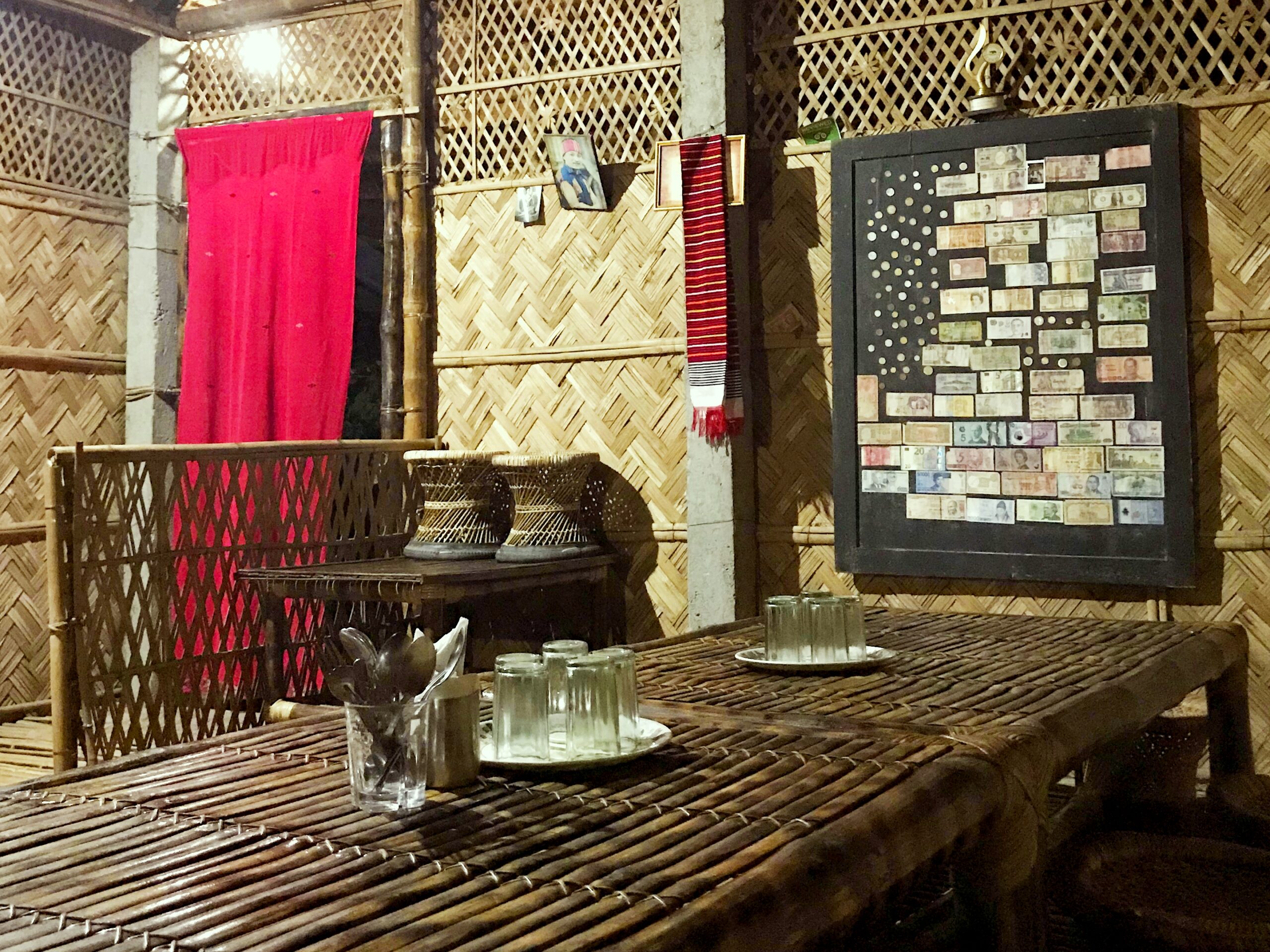
The woody smoke had now enveloped the crackling skewered chicken and vessels of freshly steamed rice were unveiled as our brass dinner plates were being laid out. Peppered papads were fire-roasted for a crackling addition to the calm meal.
Suddenly, the aromas of slow-cooked food were unleashed, filling the room with a sense of snugness. Our plates were piled with fragrant bhat (rice), mosur dal (lentils) with a delicate tempering, mildly spiced horu aalu and leseri bhaaji (baby potato and yard long beans stir fry), some bengena bhaja (home style fried aubergines), bogori achar (jujube pickle) and papad; kukura khorika (chicken skewers) was added for the non-vegetarians. At the table, conversations softened as our curiosity drifted towards the thali (platter). The meal was therapeutic, pleasantly familiar and delicately spiced, with occasional bursts of bold flavours from jolokia (chilli peppers) and boga xoriyo (mustard seeds). It offered a comforting familiarity on an esoteric, outlandish settlement, reminding us of our inherent geocultural alikeness.
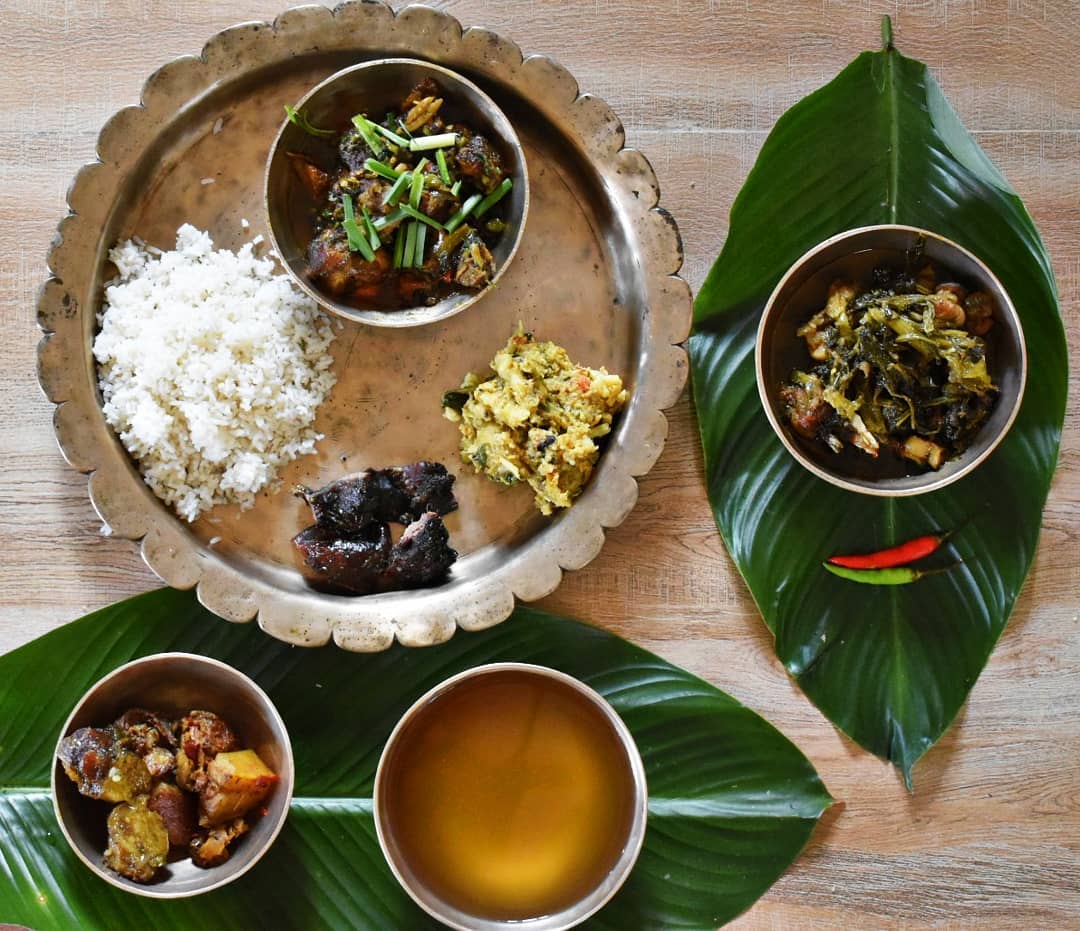
Image Source: Bhavna Doley (bhavna811)
Somewhere in some corner of this massive mystical river island, an understated meal had summoned a dozen of us. Some had escaped countries, some had escaped corporates and some had escaped a culture that failed to immerse them. Everyone sat around the same table, was served the same meal and the same stories, disregarding all demarcations.
The self-sustenance of Majuli as a community is a consequence of the calamities faced by the land and its people. Adversities draw people closer, and you begin to fully comprehend what that means when you’re sitting around the meram, and Monjit gleefully delivers a verse dedicated to Mishing food combinations – educating, entertaining and endearing you, all at once.
Hol-ay, mol-ay (whole meat and radish)
Haa-ein, bah-ein (duck and bamboo)
Kukura, kumura (chicken and white gourd)
He doesn’t remember it all but it got us wondering – how often does one be presented with this rare food rhyme, smack in the middle of one ginormous river?
Translations and detailed descriptions are provided to give a better understanding of the story to people from different cultural backgrounds across the globe.

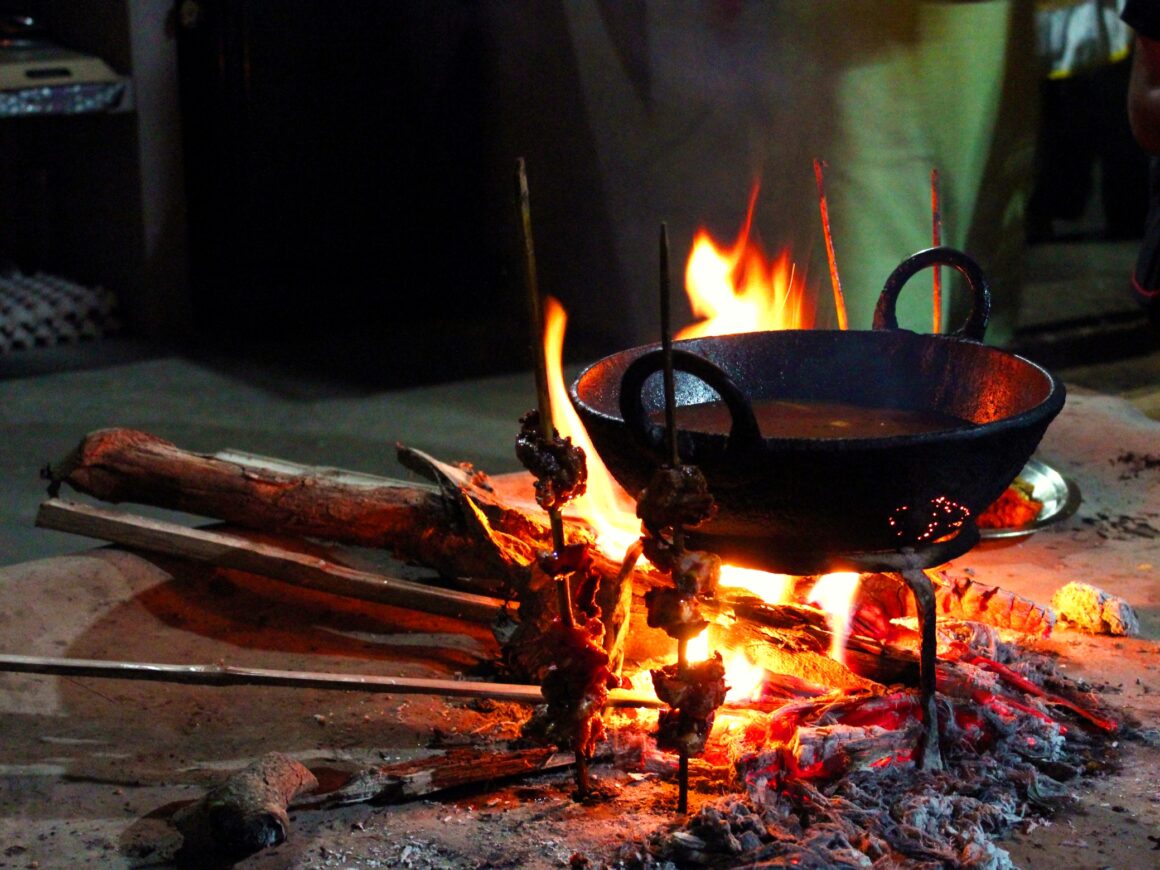
Amazing 👍 already imagining myself there😇
Thanks! Looks like you’re in a good place. 🙂
Very fine writing. It transports you to this amazing place. Longing for such a recluse.
Thank you